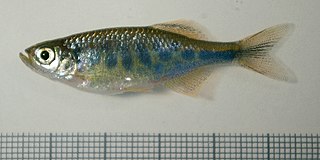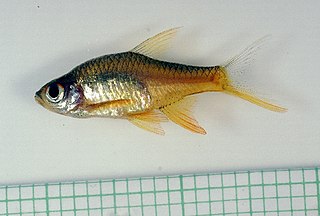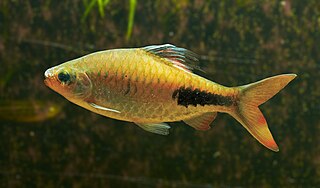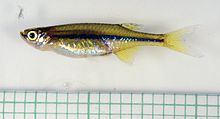
Cyprinidae is a family of freshwater fish commonly called the carp or minnow family, including the carps, the true minnows, and their relatives the barbs and barbels, among others. Cyprinidae is the largest and most diverse fish family, and the largest vertebrate animal family overall, with about 3,000 species; only 1,270 of these remain extant, divided into about 200 valid genera. Cyprinids range from about 12 mm in size to the 3 m (9.8 ft) giant barb. By genus and species count, the family makes up more than two-thirds of the ostariophysian order Cypriniformes. The family name is derived from the Greek word kyprînos.

Puntius is a genus of small freshwater fish in the family Cyprinidae native to South Asia and Mainland Southeast Asia, as well as Taiwan.

The ticto barb or twospot barb is a species of subtropical freshwater fish belonging to the family Cyprinidae. It is a native of the upper Mekong, Salwen, Irrawaddy, Meklong and upper Charo Phraya basins in the countries of Nepal, India, Pakistan, Myanmar, Bangladesh, Thailand, and Sri Lanka. It has frequently been confused with the Odessa barb in the aquarium trade, but in that species the male is reddish-orange.

Devario is a genus of fish in the family Cyprinidae native to the rivers and streams of South and Southeast Asia. These fishes have short barbels and many species having vertical or horizontal stripes. These species consume various small, aquatic insects, crustaceans and worms, as well as, in the case of fry, plankton.

Rasbora is a genus of fish in the family Cyprinidae. They are native to freshwater habitats in South and Southeast Asia, as well as southeast China. A single species, R. gerlachi, is only known from an old specimen that reputedly originated from Africa (Cameroon), but this locality is considered doubtful. They are small, up to 17 cm (6.7 in) long, although most species do not surpass 10 cm (4 in) and many have a dark horizontal stripe.

Mystus is a genus of fish in the family Bagridae native to Asia. Phylogenetic relationships within this genus are poorly understood, though it has been suggested that there are two major lineages.

Capoeta, also known as scrapers, is a genus of fish in the family Cyprinidae found in Western Asia. The distribution extends from Turkey to the Levant, to Transcaucasia, Iraq, Turkmenistan, in Armenia, particularly in lake Sevan and northern Afghanistan. This genus is most closely related to Luciobarbus and in itself is divided into three morphologically, biogeographically and genetically distinct groups or clades: the Mesopotamian clade, the Anatolian-Iranian clade and the Aralo-Caspian clade.

Rasboroides vaterifloris, known as the pearly rasbora, vateria flower rasbora or fire rasbora, is a species of freshwater cyprinid fish endemic to Sri Lanka. It can be found in the shallow waters of shaded, slow-flowing clear streams with a silt substrate. It also prefers areas with plentiful leaf debris. Its diet consists of detritus and terrestrial insects. This species can reach a length of 4 centimetres (1.6 in) TL. It can also be found in the aquarium trade.
Pethia cumingii, known as the Cuming's barb or the two spot barb, is a species of cyprinid fish endemic to Sri Lanka.
The Channa barb, is a species of cyprinid fish endemic to India where it occurs in hill streams in forested areas. This species can reach a length of 19.6 centimetres (7.7 in) TL. This species is also found in the aquarium trade. This species is the only member of its genus.
Pethia reval, the red-finned barb, is a species of cyprinid fish endemic to Sri Lanka. This species can reach a length of 3.4 centimetres (1.3 in) SL.

Rasboroides is a genus of small cyprinid fishes endemic to Sri Lanka. They are found in small, slow-flowing and shaded streams in the southwestern part of the island. They are essentially restricted to lowlands, although one introduced population occurs at an altitude of 980 m (3,220 ft). They are calm, social and attractively colored fish that sometimes are kept in aquariums.

Systomus is a genus of fish in the family Cyprinidae native to tropical Asia.

Rohan David Pethiyagoda is a Sri Lankan biodiversity scientist, amphibian and freshwater-fish taxonomist, author, conservationist and public-policy advocate.

Dawkinsia is a genus of cyprinid fishes from freshwater in South India and Sri Lanka. It was split off from genus Puntius in 2012.

Pethia is a genus of small freshwater fish in the family Cyprinidae native to South Asia, East Asia and Mainland Southeast Asia. Some species are commonly seen in the aquarium trade. The name Pethia is derived from the Sinhalese "pethia", a generic word used to describe any of several small species of cyprinid fishes. Most members of this genus were included in Puntius, until it was revised in 2012.

Haludaria is a genus of cyprinids native to freshwater habitats in the Western Ghats of India. Originally the genus was named DravidiaPethiyagoda, Meegaskumbura & Maduwage, 2012 which is preoccupied by the dipteran genus DravidiaLehrer, 2010.

The Indian glass barb, is a cyprinid fish in the family Cyprinidae found in Pakistan, India, Bangladesh, Sri Lanka, Myanmar, Nepal and Indonesia. This species is reported in Mekong and Chao Phraya.
Laubuka latens is a species of small fish of the minnow and carp family, Cyprinidae, and the Danio subfamily. It was described in 2015 from specimens collected in the Cauvery River and its tributaries in the Western Ghats of India. This species and Laubuka trevori had been thought to be local variants of the Indian glass barb but were shown to be different species. The unique features of L. latens are that it has 7½ branched rays in its dorsal fin with 5 branched rays in its pelvic fin; it has 14 precaudal vertebrae and 17–18 predorsal scales; aw s well as 5+4+2 teeth on the fifth ceratobranchial bone. It can also be distinguished from its close relatives by its plain unmarked body, lacking stripes.

Rohanixalus is a genus of tree frogs in the family Rhacophoridae native to the Andaman islands and Indo-Burma region. The genus was established in 2020 by Indian herpetologist S.D. Biju of the University of Delhi and his colleagues. The genus comprises eight species.
















